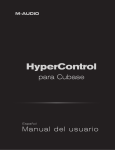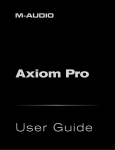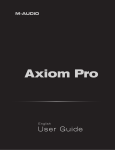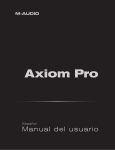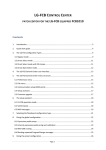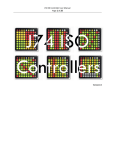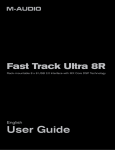Download M-Audio Axiom Line User guide
Transcript
HyperControl for Pro Tools User Guide HyperControl for Pro Tools | Axiom Pro What is HyperControl? . . . . . . . . . . . . . . . . . . . . . . . . . . . . . . . . . . . . . . . . . . . . . . . . . . 1 HyperControl Requirements . . . . . . . . . . . . . . . . . . . . . . . . . . . . . . . . . . . . . . . . . . . . . 2 Pro Tools 7.4 Software: . . . . . . . . . . . . . . . . . . . . . . . . . . . . . . . . . . . . . . . . . . . . . . . . . . . . . . . . . . 2 Axiom Pro Hardware:. . . . . . . . . . . . . . . . . . . . . . . . . . . . . . . . . . . . . . . . . . . . . . . . . . . . . . . . . . . . 2 HyperControl Installation. . . . . . . . . . . . . . . . . . . . . . . . . . . . . . . . . . . . . . . . . . . . . . . . 3 HyperControl with Axiom Pro Hardware. . Using Pro Tools with HyperControl . . . . . . . . . . . . . . . . . . . . . . . . . . . . . . . . . 5 . . . . . . . . . . . . . . . . . . . . . . . . . . . . . . . . . . . . 13 General Overview . . . . . . . . . . . . . . . . . . . . . . . . . . . . . . . . . . . . . . . . . . . . . . . . . . . . . . . . . . . . . 13 HyperControl Display and Soft-Keys . . . . . . . . . . . . . . . . . . . . . . . . . . . . . . . . . . . . . . . . . . . . . . . . . . . 14 Mixer Mode. . . . . . . . . . . . . . . . . . . . . . . . . . . . . . . . . . . . . . . . . . . . . . . . . . . . . . . . . . . . . . . . . 15 Instrument Mode. . . . . . . . . . . . . . . . . . . . . . . . . . . . . . . . . . . . . . . . . . . . . . . . . . . . . . . . . . . . . . 18 Changing HyperControl assignments (Pro Tools 8 only). . . . . . . . . . . . . . . . . . . . . . . . . . . . . . . . . . . . . . . . . 20 HyperControl for Pro Tools | Axiom Pro | 1 What is HyperControl? HyperControl is a powerful new technology that automatically maps your Axiom Pro controls (i.e., knobs, buttons, sliders 1, etc.) to the on-screen controls of Pro Tools and all of its RTAS or TDM plug-ins and virtual instruments. This helps you make music more quickly since you no longer have to perform the tedious and time-consuming task of assigning MIDI controls. Furthermore, since HyperControl is a two-way communication protocol, your Axiom Pro hardware and Pro Tools software always remain synchronized with each other. For example, if a knob is turned on Axiom Pro, its corresponding knob in Pro Tools will update. Alternatively, if an on-screen knob is turned within Pro Tools (using the mouse), the corresponding knob position of Axiom Pro (as shown on the LCD display) updates as well. If a new instrument (or a different preset within the same instrument) is loaded, the parameter names and various button, knob, and slider positions automatically update on the Axiom Pro display. This makes Axiom Pro feel like a “dedicated” hardware controller since the knobs and LCD screen are “tightly” integrated with Pro Tools and always reflect what is currently happening within your software. Finally, HyperControl allows for more than just MIDI data to be sent from Axiom Pro—ASCII keystrokes can also be sent, emulating Pro Tools keyboard shortcuts. This allows the controller to have “deep” integration into Pro Tools, and allows things like zoom presets, markers, copy, undo and many other features to be controlled right from Axiom Pro. This minimizes the amount of time you must spend using a mouse to control your software. In short, these features let you use Pro Tools more intuitively and give you more “hands on” control of your software to inspire your creativity. 1 Only available on Axiom 49/61 HyperControl for Pro Tools | Axiom Pro | 2 HyperControl Requirements Pro Tools 7.4 Software: Please note that HyperControl requires Pro Tools version 7.4 or later. Earlier versions of Pro Tools do not support HyperControl technology. To learn more about upgrading your Pro Tools software, please visit http://www.digidesign.com. Axiom Pro Hardware: HyperControl requires the presence of an Axiom Pro controller on your computer and this document assumes your Axiom Pro keyboard has already been installed and connected to your system. To learn more about this installation procedure, please see the Axiom Pro Quick Start Guide. HyperControl for Pro Tools | Axiom Pro | 3 HyperControl Installation ✓ OTE: If Pro Tools is running, close the application before beginning the HyperControl installation procedure. The N instructions below will indicate when Pro Tools should be launched. 1. HyperControl technology requires an Axiom Pro “personality” file to be present in one of the Pro Tools sub-folders. Pro Tools 8 users: Pro Tools version 8.0 and above already includes the personality files required by Axiom Pro. Please skip to the next step. Pro Tools 7.4 users: To install this file, run the M-Audio Keyboard v7.4 Installer and follow the on-screen instructions. 2. Once the installation is complete, launch Pro Tools. 3. Select “Peripherals…” from the Setup menu. 4. Select the “MIDI Controllers” tab from the window that appears. 5. Click the first “Type” drop-down menu and select “M-Audio Keyboard.” 6. Click the first “Receive From” drop-down menu and select the “Axiom Pro HyperControl In” 2 port. 7. Click the first “Send To” drop-down menu and select the “Axiom Pro HyperControl Out” 2 port. 8. Finally, make sure that “8” is selected in the “# Ch’s” drop-down menu. Once steps 1-8 are completed, click “OK.” You can now control Pro Tools with your Axiom Pro using HyperControl technology. HyperControl for Pro Tools 2 | | Axiom Pro Windows XP, Vista and Mac OS X 10.4 (Tiger) users: When using Axiom Pro class-compliant (i.e. without installing the M-Audio driver) in Windows XP/Vista or in Mac OS X 10.4 (Tiger), the Axiom Pro MIDI ports will not be displayed with their proper port names. Windows XP or Vista users: Please follow the driver installation instructions found in the printed Quick Start Guide. Mac OS X 10.4 (Tiger) users: No Mac drivers are available, since the class-compliant MIDI driver built into Mac OS X supports all features of Axiom Pro. Please see the table below for more information on port naming. Axiom Pro Class-Compliant Port Names per Operating System Macintosh Axiom Pro MIDI Input Ports Mac OS X 10.4 MIDI Input Ports Mac OS X 10.5 MIDI Input Ports Axiom Pro 61 USB A In Axiom Pro 61 Port 1 Axiom Pro 61 USB A In Axiom Pro 61 HyperControl In Axiom Pro 61 Port 2 Axiom Pro 61 HyperControl In Axiom Pro 613 MIDI In Axiom Pro 61 Port 3 Axiom Pro 61 MIDI In Axiom Pro 613 USB B In Axiom Pro 61 Port 4 Axiom Pro 61 USB B In Axiom Pro MIDI Output Ports Mac OS X 10.4 MIDI Output Ports Mac OS X 10.5 MIDI Output Ports Axiom Pro 61 MIDI Out Axiom Pro 61 Port 1 Axiom Pro 61 MIDI Out Axiom Pro 61 HyperControl Out Axiom Pro 61 Port 2 Axiom Pro 61 HyperControl Out Axiom Pro MIDI Input Ports Windows XP MIDI Input Ports Windows Vista MIDI Input Ports Axiom Pro 61 USB A In USB Audio Device Axiom Pro 61 Axiom Pro 61 HyperControl In USB Audio Device [2] MIDIIN2 Axiom Pro 61 Axiom Pro 613 MIDI In USB Audio Device [3] MIDIIN3 Axiom Pro 61 Axiom Pro 613 USB B In USB Audio Device [4] MIDIIN4 Axiom Pro 61 Axiom Pro MIDI Output Ports Windows XP MIDI Output Ports Windows Vista MIDI Output Ports Axiom Pro 61 MIDI Out USB Audio Device Axiom Pro 61 Axiom Pro 61 HyperControl Out USB Audio Device [2] MIDIOUT2 Axiom Pro 61 3 3 3 3 Windows 3 3 3 3 3 These MIDI port nameswill willdisplay display the the corresponding of keys, based on the Pro model you use:you 25,use: 49 or25, 61.49 or 61. These MIDI port names correspondingnumber number of keys, based onAxiom the Axiom Pro model 3 4 HyperControl for Pro Tools | | Axiom Pro 5 HyperControl with Axiom Pro Hardware 9 6 10 8 2 1 3 4 5 7 1.Slider Buttons 4 – These buttons let you select, record arm, mute, or solo tracks within Pro Tools. By default, these buttons select channels, however, pressing the Flip button 4 lets you step through three other functions: record arm, mute, solo. You can select multiple mixer channels by holding down the “Control” key on your computer keyboard while pressing the Slider Buttons; holding the “Shift” key of your computer keyboard while pressing these buttons will select a range of mixer channels. For example, holding the Ctrl key and pressing “1” and “5” will select the first and fifth mixer channels in Pro Tools; holding the Shift key and pressing “1” and “5” will select channels one through five on the Pro Tools mixer. ✓ TI P: It is possible to set the Drum Pads or Numerical Keypad of your Axiom Pro to replicate keystrokes of your standard computer keyboard (such as “Ctrl” or “Shift”). This will allow you to select multiple Pro Tools mixer channels using only the Axiom Pro keyboard (i.e., no computer keyboard is required). Please refer to the “Edit Mode > Group (Numerical Keypad)” section of the Axiom Pro User Guide to learn how to do this. 2.Sliders 4 – These sliders control their corresponding bank of eight faders in the Pro Tools mixer. Note that all Pro Tools track names that are currently under the control of Axiom Pro are outlined in blue, as shown below: Selected Bank of Tracks (Controlled by Axiom Pro) Unselected Bank of Tracks 3.Master Fader 4 – This slider automatically maps to the Master Fader track of your Pro Tools session; If you have not created a Pro Tools Master Fader track, this slider will have no effect on your session. ✓ NOTE: If you have created more than one Master Fader track, this slider will control the right-most Master Fader track in the Pro Tools mixer. 4 Only available on Axiom Pro 49/61. HyperControl for Pro Tools | Axiom Pro | 6 4.Flip Button 5 – Axiom Pro can operate in two different modes when using HyperControl: Mixer Mode and Instrument Mode. The functionality of the Flip button varies depending on the mode that you are in (the “F1” F-Key selects the mode; see the “F-Keys” section below for more information). Mixer Mode: When Axiom Pro is in Mixer Mode, the flip button determines the function of the Slider buttons 1 . By default, the Slider buttons select channels within your Pro Tools session. However, pressing the Flip button 4 lets you step through the other functions that the Slider buttons can perform (i.e., record arm, mute, solo). When you press the Flip button, the functionality of the Slider Buttons is listed near the lower-left side of the screen. Insert / Instrument Modes: W hen Axiom Pro is in Instrument Mode or when an Insert is selected within Pro Tools, the Axiom Pro Sliders 2 control Pro Tools track volume settings whereas the Encoder knobs 5 control the parameters of your selected insert plug-in or virtual instrument. The Flip Button can be used to exchange (or “flip”) the function of the Encoder knobs and the Sliders. This lets you use the Axiom Pro Sliders to adjust insert or virtual instrument settings, while using the Encoder knobs to set track levels. Use this button to engage and disengage fader flipping. When engaging this mode, “Flip Faders On” is displayed in the lower-left side of the screen. ✓ NOTE: Switching back to Mixer Mode will cancel Flip Faders mode. 5.Encoder Knobs – These knobs automatically map to the parameters of the Pro Tools tracks or virtual instrument controls that are currently selected through Axiom Pro. The “Using Pro Tools with HyperControl” section of this guide describes how you can select different kinds of track and instrument parameters for these knobs to control. 6.Soft-Keys – These four buttons correspond to the “Pages” displayed along the bottom of the LCD screen and let you access various parameters of your Pro Tools tracks (i.e., volume, pan, and insert settings, send levels, etc.) and virtual instrument settings. The “HyperControl Display and Soft-Keys” section covers these buttons in detail. 5 Only available on Axiom Pro 49/61. HyperControl for Pro Tools 7. | Axiom Pro Transport Controls – These buttons map to the Pro Tools Transport and provide other useful functions. Axiom Pro Control Functionality within Pro Tools Rewind. Tapping this button will skip to the beginning of the previous bar (or time/sample delineation, if the Main Counter is set to show time or samples). Holding this button will rewind the Pro Tools transport until the button is released. Fast Forward. Tapping this button will skip to the beginning of the next bar (or time/sample delineation, if the Main Counter is set to show time or samples). Holding this button will rewind the Pro Tools transport until the button is released. Stop. This buttons stops recording or playback. Play. This button starts recording or playback. Record. This button record-enables the Pro Tools transport. + Return to Start. Holding down the Loop button while pressing the Rewind button rewinds to the beginning of your Pro Tools session. + Go to End. Holding down the Loop button while pressing the Fast Forward button advances to the end of your Pro Tools session. + Undo. Holding down the Loop button while pressing the Stop button cancels the last action that was made in Pro Tools (this is the same as selecting Edit > Undo within Pro Tools. + Engage Loop Play. Holding down the Loop button while pressing the Play button engages looping between the Loop Start and Loop End points as specified in the Pro Tools transport. Press this combination of buttons again to disengage looping. + Engage Loop Record. Holding down the Loop button while pressing the Record button engages the “Loop Record” function of Pro Tools. Press this combination of buttons again to disengage looping. Please see the Pro Tools documentation to learn more about the loop recording function. | 7 HyperControl for Pro Tools | Axiom Pro | 8 8.F-Keys – These buttons let you navigate through Pro Tools and let you accomplish several other tasks without using a mouse or computer keyboard. ✓ A xiom Pro 25 Users: Due to space limitations, Axiom Pro 25 does not feature dedicated F-Keys. Instead, the Soft-Keys on the bottom row can be converted to F-Keys by pressing the “F-Keys” Function button on the top row. Note that Axiom Pro 25 only supports F-Keys 1 through 4 (Mode, < Track, Track >, and Mute); it does not have F-keys 5-7 (Solo, < Bank, and Bank >). • F1 (Mode)Axiom Pro can operate in two different modes when using HyperControl: Mixer Mode and Instrument Mode. This button toggles between the two modes. • F2 (< Track)This button selects and record-enables the previous track within Pro Tools. For example, if track 8 is currently selected, pressing this button will select track 7 and enable recording for that track. The name of the currently selected track is highlighted in white. • F3 (Track >)This button selects and record-enables the next track within Pro Tools. For example, if track 1 is currently selected, pressing this button will select track 2 and enable recording for that track. The name of the currently selected track is highlighted in white. • F4 (Mute) This button mutes the track that is currently selected within Pro Tools. • F5 (Solo) This button solos the track that is currently selected within Pro Tools. • F6 (< Bank) All Pro Tools track names that are currently under the control of Axiom Pro are outlined in blue. This button selects the previous bank of eight tracks. For example, if tracks 9-16 are currently outlined, pressing this button will select tracks 1-8. • F7 (Bank >) All Pro Tools track names that are currently under the control of Axiom Pro are outlined in blue. This button selects the next bank of eight tracks. For example, if tracks 1-8 are currently outlined, pressing this button will select tracks 9-16. ✓ N ote to Axiom Pro 25 Users: While Axiom Pro 25 does not feature Bank buttons, bank selection can still be performed using the “< Track” and “Track >” (F2, F3) buttons and selecting the track beyond the bounds of the currently selected bank. For example, if the right-most track of the current bank is selected and the “Track >” button is pressed, the next bank of tracks will become active. Alternatively, if the left-most track of a current bank is selected and the “< Track” button is pressed, the previous bank will become active. HyperControl for Pro Tools | Axiom Pro | 9 9.Load Button – This button brings up a prompt allowing you to load stored Axiom Pro patches. Loading of patches is covered in the “Function Buttons and Soft Keys” section of the Axiom Pro User Guide. Save Button – This button brings up a prompt allowing you to save the current settings of your Axiom Pro. Saving of patches is covered in the “Function Buttons and Soft Keys” section of the Axiom Pro User Guide. Hold (Load + Save Buttons) – By default, the LCD screen displays the position and status of the last control that was used. For example, if the screen is displaying the status of the drum pad group and you turn an encoder knob, the LCD will immediately switch to the encoder group, highlight the encoder that was turned, and display that encoder’s associated parameter and value on the lower-left side of the screen. In certain cases, you may want to ”hold” the information on the LCD, preventing the screen from updating when a control of a different group is moved. To do this, simultaneously press and hold the Save and Load buttons. When the display is locked, if you move a control outside the “locked” group, you will still see the control’s parameter name and value in the display, but the text on the LCD will remain in place. Pressing the Save and Load Buttons again will disable the Hold feature. HyperControl for Pro Tools | Axiom Pro | 10 Why do I need patches? Doesn’t HyperControl assign controls automatically? HyperControl technology automatically handles the assignment of most Axiom Pro controls and—in many cases—you will not need to load or save any Axiom Pro patches. However, there are some cases in which you may need to use customized patches: 1.Using external MIDI hardware. If you are using Pro Tools to control hardware MIDI devices (synthesizers, samplers, etc.), you will need to load a customized patch that assigns MIDI CC values of Axiom Pro controls (encoder knobs, sliders 6, etc.) to the parameters of your hardware device. ✓ OTE: When controlling external MIDI devices, the “HyperControl” parameter N must be set to “Transport.” Please refer to the “Edit Mode (Main Menu)” section of the Axiom Pro User Guide to learn how to do this. 2.Assigning the performance controls (drum pads, keyboard zones, sustain/expression pedals, etc.) and the numerical keypad 6. The numerical keypad is not automatically assigned so that you can still customize some of the Axiom Pro controls to your preference even if HyperControl is in use. For example, you can assign Pro Tools keyboard shortcuts to the buttons of the Axiom Pro keypad. Before you begin customizing the keypad, note that Axiom Pro ships from the factory with a number of useful patches that may already assign the numerical keypad to functions you wish to use. Please see Appendix A at the end of the Axiom Pro User Guide to learn how each factory patch is configured. The performance controls are not automatically assigned by HyperControl so that you can set note, zone, and other assignments to your preference. For example, your virtual instrument may require you to assign the pads to send specific MIDI note or velocity values. Alternatively, you may wish to configure keyboard zones in a specific way to help you accomplish a specific task. This can be done through Edit mode. Please see the Axiom Pro User Guide to learn how to do this. 3.Running Pro Tools and other audio applications concurrently. It is possible to simultaneously use Pro Tools and other audio applications at the same time. When working in this configuration, Pro Tools makes use of HyperControl technology while your other audio applications are controlled using standard MIDI messages (i.e., Axiom Pro acts as a “traditional” MIDI controller keyboard). ✓ 6 OTE: When controlling audio applications that are running alongside Pro Tools, N the “HyperControl” parameter within Axiom Pro must be set to “Transport.” Please refer to the “Edit Mode (Main Menu)” section of the Axiom Pro User Guide to learn how to do this. Only available on Axiom Pro 49/61. HyperControl for Pro Tools 10. | Axiom Pro | 11 Edit Button – This button lets you enter and exit Edit Mode. When using HyperControl, many of the Axiom Pro controls (i.e., buttons, knobs, transport controls, etc.) are automatically assigned to the on-screen controls of your software. However, you can customize the numerical keypad 12 and performance controls (the drum pads, keyboard zones, sustain/expression pedals, etc.) to your personal preference by using Edit Mode. This mode is covered in greater detail in the “Edit Mode” section of the Axiom Pro User Guide. ✓ N OTE: It is possible to set HyperControl to only map the Axiom Pro transport controls to Pro Tools while allowing all other control groups (encoder knobs, sliders 7, buttons, etc.) to function like a traditional MIDI controller. This is useful when working with MIDI tracks that route to external MIDI hardware devices (e.g. synthesizers) as it allows transmission of customized MIDI messages such as standard MIDI CC data. To do this, enter Edit Mode and change the “HyperControl” parameter (on the main menu) from “Normal” to “Transport.” For more information, see the “Edit Mode” section of the Axiom Pro User Guide. Note that HyperControl “Transport” and “Normal” modes can be toggled on the fly while HyperControl is active. This lets you switch between “normal” HyperControl assignments and an additional set of your own custom controller assignments that you can specifically tailor to the external MIDI devices you wish to control. 11.Zone/Group Button – This button switches the functionality of the buttons beneath the Sliders (on Axiom Pro 49/61) or Transport Control (on Axiom Pro 25) and allows you to select the Performance Groups and Zones. When the button is not illuminated (i.e., not pressed), the associated buttons send out HyperControl commands. When the button is pressed, it becomes illuminated, and the associated buttons can then be used to activate/deactivate Zones and Groups. The “Edit Mode > Zones” section of the Axiom Pro User Guide covers this subject in greater detail. P eek (Edit + Zone/Group Buttons) – Regardless of what is currently displayed on the Axiom Pro LCD, you can always bring the list of encoder knob assignments in view by simultaneously pressing the Edit and Zone/Group buttons. For example, if knob positions are being displayed on screen but you would like to return to the “home” screen that shows Pro Tools track names or the knob assignments of insert/virtual instrument plug-ins press the Edit and Zone/Group buttons. The Peek function also lets you check the current value of a specific knob without changing its corresponding Pro Tools parameter. To do this, press and hold the Edit and Zone/Group buttons while moving the desired control. This will list the moved control’s current value without causing any changes to your Pro Tools track, insert, or virtual instrument. 7 Only available on Axiom Pro 49/61. HyperControl for Pro Tools | Axiom Pro | 12 12.Numerical Keypad 7– The numerical keypad buttons can be programmed to send MIDI commands as well as ASCII keystrokes (just like a computer keyboard). These ASCII keystrokes can correspond to your audio application’s “keyboard shortcuts” allowing you to access various features of your software straight from Axiom Pro (i.e., without having to touch your computer keyboard). Axiom Pro ships with a variety of pre-programmed patches that map these buttons to popular audio applications (a list of these patches can be found in Appendix A of the Axiom Pro User Guide). For example, when using HyperControl with Pro Tools, the numerical keypad can be used to perform the following by loading preset 2 (Mac) or preset 3 (PC): Axiom Pro Keypad Default function within Pro Tools (Preset 2 for Mac; Preset 3 for Windows) 1 Save session 2 Toggle click on/off 3 Toggle between Edit and Mix windows 4 Duplicate selected region 5 Set loop “in” point (during playback) 6 Set loop “out” point (during playback) 7 Ctrl 8 Cmd (Mac) / Start (PC) 9 Opt (Mac) / Alt (PC) — (Minus) Zoom out (horizontal) 0 Shift + (Plus) Zoom in (horizontal) See the “Edit Mode > Control” section of the Axiom Pro User Guide to learn how to make customized patches for these buttons. ✓ T I P: W hen working in Edit Mode, these buttons allow Axiom Pro 49/61 users to enter numerical values quickly. Axiom Pro 25 users can enter values by using the black piano keys (the keys range from 0-9 as you move from left to right on the keyboard). 7 Only available on Axiom Pro 49/61. HyperControl for Pro Tools | Axiom Pro | 13 Using Pro Tools with HyperControl General Overview HyperControl is designed to let you intuitively control Pro Tools, its plug-ins, and its virtual instruments with little or no use of your computer’s mouse or keyboard. The Transport Controls 7 give you instant access to the Pro Tools transport and let you start, stop, record, loop, as well as perform various other tasks straight from the Axiom Pro keyboard: he F1-F7 F-Keys (F1-F4 on Axiom Pro 25) 8 let you select, solo, and mute tracks within your Pro Tools session without T having to use a mouse. When a track is selected using the F2-F3 (Track) keys, its name is highlighted within Pro Tools and it is automatically record-enabled to help you begin recording quickly. These keys are covered in further detail on page 8. he Slider buttons 8 1 can be used in conjunction with the Flip button 8 4 to select, record arm, mute, or solo channels within T the Pro Tools Mixer. See the “Flip Button” section on page 6 to learn how to do this. The eight Sliders 8 2 of Axiom Pro usually control the levels of the selected tracks within the Pro Tools mixer. You can use the F2-F3 (Track) or F6-F7 (Bank) F-Keys to select which Pro Tools channels are currently being controlled by the Sliders of Axiom Pro (the names of active channels are outlined in blue within Pro Tools). If you have created a Master Fader track for your Pro Tools session, the right-most fader 8 3 of Axiom Pro will control the level of that Master Fader track. If you have created more than one Master Fader track, the Axiom Pro Master Fader always controls the right-most Master Fader track of the Pro Tools mixer. If you have not created a Pro Tools Master Fader track, this slider will have no effect on your session. Finally, any time you switch to a new page using the Soft-Keys (i.e., to the “Home”, “Ins”, “Sends”, and “Chan” pages), the LCD screen will show a list of Pro Tools track names or insert/virtual instrument parameters that will be controlled by the Encoder knobs 5 . If any of the Axiom Pro controls (i.e., pads or sliders 8 ) are moved, the LCD screen will update to show the position of the currently used control and its group, however the encoder knobs will continue to control the parameters that were shown on the “Home” screen. If you would like to return to the home screen that shows the assignment of each encoder knob, simultaneously press the “Edit” and “Zone/Group” buttons on Axiom Pro. 8 Only available on Axiom Pro 49/61. HyperControl for Pro Tools | | Axiom Pro 14 HyperControl Display and Soft-Keys HyperControl can control Pro Tools from any window within the DAW regardless of whether the “Edit,” “Mix,” or plug-in/virtual instrument window is currently selected. However, Axiom Pro is ideally suited to control Pro Tools when in a sequencing environment (i.e., while working within the “Edit” window) since the Axiom Pro display and controls can handle Pro Tools mixing functions while your computer monitor helps you arrange your music. The default “Home” screen is shown below: The upper-right corner of the display lists the parameter, insert, or virtual instrument that the Encoder Knobs are currently controlling. The name of the currently selected Pro Tools track is displayed at the top-left of the screen. Any time a slider, knob, or other control is moved on Axiom Pro, the corresponding Pro Tools parameter and its value are listed in this line. The bottom row lists menus and options that can be accessed using Soft-Keys 1-4. As indicated in the top-right corner of the example screen shown above, this page allows you to set Pan positions of your Pro Tools tracks by using the Encoder knobs. The two columns display the track names of your Pro Tools session (“Vox Lead” through “VirtInst” in this example). These tracks are currently under the control of the Axiom Pro encoders: the left column (Vox Lead, Harmony, Guitar, Bass) always corresponds to Encoder knobs E1-E4 whereas the right column (Kick, Snare, Overheds, VirtInst) corresponds to Encoder knobs E5-E8. The Soft-Keys of Axiom Pro allow you to select the four different HyperControl pages that are listed along the bottom of the display (“Home,” “Ins,” “Sends,” and “Chan”). When a new page is loaded, the Encoder knobs automatically map to the parameters listed on the newly loaded page. For example, in the picture shown above, pressing Soft-Key 3 (Sends) accesses the Sends page of HyperControl and lets you use the Encoder knobs to control send levels that you’ve assigned in the Pro Tools mixer. Note that if the Encoder knobs are not assigned to control any parameters within Pro Tools, turning a knob will have no effect on your Axiom Pro display or Pro Tools session. The center of the screen displays either the names of the Pro Tools tracks that are under the control of Axiom Pro or the current position of the knobs, sliders, or other controls of Axiom Pro. ✓ What about the Sliders? The Axiom Pro 49/61 Sliders always control the volume faders of your selected tracks within Pro Tools. This happens regardless of what page is currently loaded using Soft-Keys 1-4 (the loaded page only affects the Encoder knobs). The only exception to this rule is if Axiom Pro is either in “Instrument” or “Insert” mode and “Flip Faders” mode is activated. When Flip Faders mode is activated, the sliders are used to control insert and virtual instrument parameters, while the Encoder knobs are used to set track levels. HyperControl for Pro Tools | Axiom Pro | 15 Mixer Mode The HyperControl menus are as follows: 1. “Home” Page This is the default “Home” page of HyperControl. On the Home page, the Encoder knobs of Axiom Pro are assigned to control the pan position of your selected Pro Tools mixer channels. Since Axiom Pro 25 does not feature any sliders, pressing the “Home” Soft-Key lets you use the Encoder knobs to control both track level and pan position by toggling between the ‘Home’ (Track Volume control) and ‘Pan’ (Pan control) pages. ✓ NOTE: When using stereo tracks within Pro Tools, the Encoder knobs will let you control the top pan control by default. To control the bottom pan control, press Soft-Key 1 (Home). Axiom Pro 25 users can press the Home Soft-Key once again to control track levels. Soft-Keys 2-4 (Ins, Sends, Chan) will take you to the Inserts, Sends, and Channel HyperControl pages. These are explained below. HyperControl for Pro Tools | Axiom Pro | 16 2. “Ins” Page If you have loaded an insert plug-in on your selected Pro Tools mixer track, pressing this button displays the parameters of that plug-in and will allow you to control the plug-in using the Encoder knobs. In the example shown above, the D-Verb plug-in is loaded into track “Vox Lead” of Pro Tools. If you would like to increase the Wet/Dry level of the plug-in, turn Encoder Knob E3. If the inserted plug-in features multiple pages of parameters that can be controlled by Axiom Pro, use Soft-Keys 3-4 (“< Page” and “Page >”) to step through all of the available parameters. If the Pro Tools mixer has more than one insert on a track, press Soft-Key 2 (Ins) to step through all of the inserts available on that track. Pressing and holding Soft-Key 2 (Ins) will open and close the plug-in window. Pressing Soft-Key 1 (Home) will return you to the HyperControl Home page. 3. “Sends” Page The Send page allows you to use the Encoder knobs to set effect send levels for your Pro Tools mixer tracks. It is possible to access up to five effect send slots for each mixer channel (“Send A” through “Send E”). You can step through these slots by repeatedly pressing Soft-Key 3 (Sends). The current effect send slot is listed on the top-right of the screen. Note that the Encoder knobs control the same Send slot across the selected bank of Pro Tools channels. For example, if “Send A” is selected for tracks 1 – 8, turning Encoder Knob E1 will affect the first channel’s Send A level, Encoder Knob E2 will affect the second channel’s Send A slot, and so on. If you would like to simultaneously control two or more send levels on a single channel of Pro Tools, press Soft-Key 4 (Chan) to access the “Channel” HyperControl page. The Channel page is described below. ✓ NOTE: You must first assign and activate a send on your Pro Tools mixer channel before you can use the Sends page. If no send has been assigned, turning an Encoder Knob will not have any effect within Pro Tools (or the Axiom Pro display). Pressing Soft-Key 1 (Home) or Soft-Key 2 (Ins) will take you to the Home and Insert HyperControl pages, respectively. HyperControl for Pro Tools | Axiom Pro | 17 4. “Chan” Page Whereas the “Home” and “Sends” HyperControl pages provide a global overview of one parameter across a bank of eight Pro Tools tracks, this page provides a detailed view of all parameters on one specific Pro Tools channel. This page lets you use the Encoder knobs to simultaneously control both Left and Right pan faders (if a stereo channel is used) as well as all of the effect send levels of one channel without having to step through multiple sub-menus (Send A through Send E, for example). In the example shown above, Send A and Send B have been assigned to Bus 1-2 and 3-4, respectively. If sends have been assigned to other busses (or to the outputs of your audio interface), these busses or outputs will be listed on the Axiom Pro display. If a send has not been assigned, “no send” will be displayed on Axiom Pro. ✓ NOTE: Since the Chan page has up to seven editable parameters, Encoder Knob E8 is never used on this page. HyperControl for Pro Tools | | Axiom Pro 18 Instrument Mode Axiom Pro can operate in two different modes when using HyperControl: Mixer Mode and Instrument Mode. The previous sections of this User Guide have covered Mixer Mode. This section covers Instrument mode and describes how HyperControl and Axiom Pro can be used to give you “hands-on” control over your virtual instrument plug-ins. To use Instrument Mode, you must first: 1. Create an Instrument Track within Pro Tools. 2. Load a virtual instrument into one of the instrument track’s insert slots. 3.Make sure that the track containing your virtual instrument is selected within Pro Tools (for example by using the F2 and F3 ‘Track’ keys on Axiom Pro or by clicking the name of the track that contains your virtual instrument). 4. Finally, press the F1 “Mode” button to enter Instrument mode. (Pressing Mode again will return you to Mixer Mode). If a virtual instrument has been loaded on the selected track, a page similar to the one shown below will be displayed on your Axiom Pro. If the selected Pro Tools track does not contain a virtual instrument, pressing the Mode button will list “NoInstr” at the top-right corner of the display and the center of the display will be blank. The name of the currently selected Pro Tools track is displayed at the top-left of the screen. The name of the virtual instrument is displayed at the top-right of the screen. The bottom row lists menus and options that can be accessed using Soft-Keys 1-4. These options are described in detail in the following section of this guide. The center of the screen displays the various parameters contained by the virtual instrument. The listed parameters can be modified by the Encoder Knobs of Axiom Pro. HyperControl for Pro Tools | Axiom Pro | 19 Using Instrument Mode: The parameters of your virtual instrument are listed on screen and are automatically mapped to the eight Encoder knobs of Axiom Pro. The parameters in the left column are mapped to Encoder knobs of the top row whereas the right column parameters are mapped to Encoder knobs on the bottom row. Pressing Soft-Key 2 (Plugin) allows you to show or hide the virtual instrument’s window on your computer monitor. If a virtual instrument contains more than eight parameters, the controls are listed on multiple pages that can be accessed by using Soft-Keys 3-4 (labeled “< Page” and “Page >” on the LCD screen). Alternatively, if you are viewing the Instrument Mode default page, you can press the Soft-Key 1 (labeled “1-8” on the LCD screen) for quick access to the first eight pages of the virtual instrument’s parameters, as shown below: Once the “1-8” Soft-Key is pressed, the first Soft-Key (now labeled “1&2”) lets you access the first two pages (press once for page one; press twice for page two). Similarly, the second, third, and fourth Soft-Keys let you access pages 3-4, 5-6, and 7-8 respectively. ✓ NOTE: Unlike certain DAW applications, Pro Tools handles virtual instrument plug-ins in the same fashion as insert effect plug-ins. This means that you can control the parameters of your virtual instruments through the “Ins” page (in Mixer Mode) or through Instrument Mode of Axiom Pro. While your virtual instrument can be controlled through either mode, please be advised that the Soft-Key options are slightly different among the two modes: Mixer Mode has “Home”, “Ins,” “< Page” and “Page >” Soft-Keys whereas Instrument Mode has “1-8”, “Plugin,” “< Page” and “Page >”. It is recommended that virtual instruments are controlled using Instrument mode since the Soft-Keys are slightly better suited for this task. Note that Instrument Mode cannot be used to access insert effects plug-ins. To access an insert plug-in through HyperControl, you must be in Mixer Mode (i.e., not Instrument mode). ✓ T I P: C hanging presets on Digidesign A.I.R. virtual instruments You can step through the presets of virtual instruments designed by the Digidesign’s A.I.R. group by holding Soft-Key 2 and pressing Soft-Keys 3 or 4. HyperControl for Pro Tools | Axiom Pro | 20 Changing HyperControl assignments (Pro Tools 8 only) Users of Pro Tools 8.0 (and higher) can change HyperControl assignments by using the “Learn” button at the top of each plug-in or virtual instrument window. To do this: 1. Click the “Learn” button. 2. Click on an on-screen control within the plug-in or virtual instrument window. 3.Move one of the hardware controls (buttons, knobs, sliders, etc.) of Axiom Pro. This will assign your selected on-screen control to the chosen hardware control of Axiom Pro. Repeat steps 2-3 for any other controls you wish to re-assign. 4. When you are finished, click the “Learn” button of your plug-in or virtual instrument again to exit Learn Mode. ✓ N OTE: Once a knob is assigned to a new on-screen control, the original assignment of the knob is “forgotten.” For example, if an Axiom Pro encoder knob is assigned to control volume, but you re-assign the knob to control panning, the knob will no longer control volume. © 2008 Avid Technology, Inc. All rights reserved. Product features, specifications, system requirements and availability are subject to change without notice. Avid, M-Audio, Axiom Pro, HyperControl and Pro Tools are either trademarks or registered trademarks of Avid Technology, Inc. All other trademarks contained herein are the property of their respective owners. M-Audio USA M-Audio Germany Technical Support Technical Support Sales Sales Web. . Web. . . . . . . . . . . . . . . . . . . . . . . . . . . . . . . . . . . M-Audio U.K. M-Audio Canada Technical Support Technical Support Sales Web. . Sales . . . . . . . . . . . . . . . Benelux Web. . . . . . . . . . . . . . . . . . . Technical Support Belgium tel. . . . . . . . . . . . . . +32 22 54 88 93 Holland tel . . . . . . . . . . . . . +31 35 625 0097 M-Audio France M-Audio Japan エムオーディオ/アビッドテクノロジー株式会社 〒107-0052 東京都港区赤坂 2-11-7 ATT新館ビル4F Avid Technology K K | M-Audio 4F ATT Bldg 2-11-7 Akasaka, Minato-ku Tokyo 107-0052 Japan カスタマーサポート(Technical Support) Renseignements Commerciaux セールスに関するお問い合わせ(Sales) Assistance Technique Web . . Web. . . . . . . . . . . . . . . . . . . . . . . . . . . . . . . . . . .























